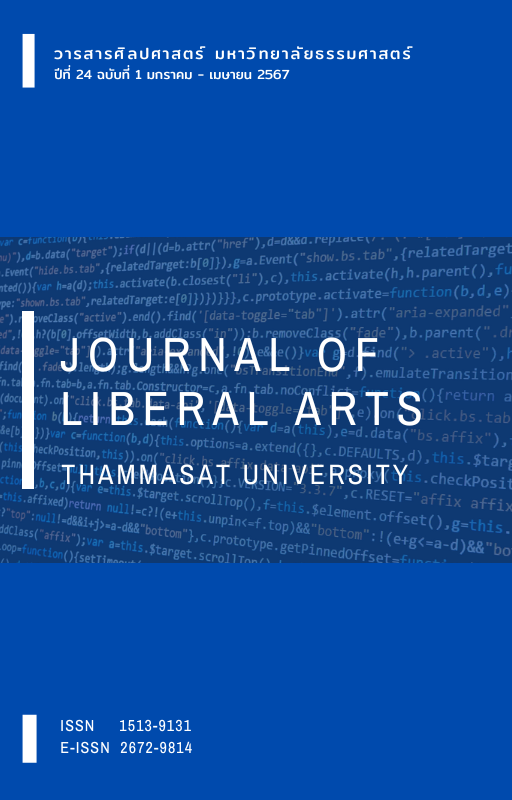Literary Analysis of Mary’s Lineage: Unraveling the Controversy in Quranic and Biblical Texts within the Context of Literary Studies
Main Article Content
บทคัดย่อ
The controversy over Mary being termed the “sister of Aaron” in the Quran prompts a critical examination of its impact on the Quranic narrative. This study explores historical, literary, and cultural contexts, utilizing intertextuality in the Quranic and Christian traditions. Employing a methodology involving a thorough analysis of Biblical and Quranic texts, along with relevant secondary literature, we scrutinize language styles, genre specifications, and cultural contexts. The investigation reveals diverse perspectives on Mary’s lineage. In alignment with some mainstream Islamic interpretations, the paper posits that the Quran’s reference to Mary as Aaron’s sister is symbolic, not a literal biological relationship. This interpretation is supported by the distinctive portrayal of Aaron in the Quran and the Bible, emphasizing Mary’s unique role. Additionally, the paper draws evidence from accepted religious sources in Jewish and Christian traditions, reinforcing the Quranic term “Mary, sister of Aaron.” In conclusion, the study advocates for a nuanced understanding, asserting that interpreting the Quran’s symbolic connections does not undermine its authenticity. Instead, it aligns with a broader tradition of symbolism and intertextuality in religious texts, reinforcing the Quran’s distinct portrayal.
Downloads
Article Details

อนุญาตภายใต้เงื่อนไข Creative Commons Attribution-NonCommercial-NoDerivatives 4.0 International License.
เอกสารอ้างอิง
Ali, A. Y. (2016). The meaning of the holy Quran: Explanatory, English translation, commentary, and comprehensive index. Amana Publications.
Asad, M. (1980). The message of the Quran. Dar al-Andalus.
Bolinger, H. (2020, June 15). What is biblical typology? Christianity.com. Retrieved December 6, 2022, from https://www.christianity.com/wiki/christian-terms/what-is-biblical-typology.html
Brock, S. (2006). The Genealogy of the Virgin Mary in Sinai Syr. 16. Scrinium, 2(1), 58-71.
Carmichael, C. (1995). Incest in the Bible. Chicago-Kent Law Review, 71(1), 123-147.
Crone, P. (2016). Jewish Christianity and the Quran (Part Two). Journal of Near Eastern Studies, 75(1), 1-21. https://doi.org/10.1086/684957
Dawood, N. J. (2014). The Koran: extensively revised edition published with additional notes. Penguin Books.
Dummelow, J. R. (Ed.). (1909). A commentary on the Holy Bible. Macmillan.
Dye, G. (2022). The Qur’anic Mary and the Chronology of the Qur’an. In G. Dye (Ed.), Early Islam: The Sectarian Milieu of Late Antiquity? (pp. 159-201). Editions de l’Université de Bruxelles.
Findlay, J. D. (2017). From Prophet to Priest: The Characterization of Aaron in the Pentateuch. Peeters.
Ibn Kathir, A. I., & Mubarakpuri, S. R. (2003). Tafsir ibn Kathir: (abridged) Surat al Isra’, verse 39 to the end of Surat al Muminun (2nd ed., Vol. 6). Darussalam.
Katheer, I. (2010). Life and times of the messengers. Darussalam.
Katheer, I., & Maqbool, H. (2006). Stories of the prophets: Peace be upon them. International Islamic Publishing House.
Kathir, I. (2013). Stories of the prophets (English). Dar Al Kotob Al Ilmiyah.
Khadem, N., Sharaphy, A., Latifnejad, R., Hammod, N., & Ibrahimzadeh, S. (2007). Comparing the efficacy of dates and oxytocin in the management of postpartum hemorrhage. Shiraz E-Medical Journal, 8(2), 64-71.
King James Bible. (2017). King James Bible Online. https://www.kingjamesbibleonline.org/ (Based on the original English version first published in 1611, with significant revisions in the Oxford edition published in 1769)
Laymon, C. M. (Ed.). (1971). The interpreter’s one volume commentary on the Bible: Introd. and commentary for each book of the Bible including the Apocrypha, with general articles. Abingdon Press.
Malasit, D. (2006). The Bible’s influence on the English language. Journal of Liberal Arts Thammasat University, 6(2), 15-36.
Margoliouth, D. S. (2003). Mohammed and The Rise of Islam. Gorgias Press LLC.
McDowell, J. (1986). Evidence that demands a verdict. Here’s Life Publishers.
Miller, R. J. (2008). The Illegitimacy of Jesus in the Gospel of Matthew. Juniata Voices, 8, 24–36.
Miller, R. J. (2023, February 28). Was Jesus illegitimate?. Bible Odyssey. https://www.bibleodyssey.org/passages/related-articles/was-jesus-illegitimate/
McGrath, J. (2007). Was Jesus illegitimate? The evidence of his social interactions. Journal for the Study of the Historical Jesus, 5(1), 81-100.
Mourad, S. A. (2008). Mary in the Qur’an: A reexamination of her presentation. In G. S. Reynolds (Ed.), The Qur’an in Its Historical Context (pp. 163-174). Routledge.
Muzaqqi, A. (2016). Imran’s family in the Quran: A thematic study using qashash fî al-Qur`ân approach [Undergraduate (S1) thesis, State Islamic University Walisongo]. Walisongo Repository. https://eprints.walisongo.ac.id/id/eprint/6920/
Neuwirth, A., Sinai, N., & Marx, M. (2011). The Quran in context: Historical and literary investigations into the Quranic milieu. Brill.
Ondich, J. (2022). Reading the bible as literature: A journey. Minnesota State Colleges and Universities.
Pelikan, J. J. (2022, November 11). Mary. Encyclopedia Britannica. https://www.britannica.com/biography/Mary-mother-of-Jesus
Seiglie, M. (2018, December 6). Was Jesus born on Christmas Day? United Church of God. https://www.ucg.org/beyond-today/beyond-today-magazine/was-jesus-born-on-christmas-day
Stowasser, B. F. (1996). Women in the Quran, traditions, and interpretation. Oxford University Press.
The Qur’an (M.A.S Abdel Haleem, Trans.). (2004). Oxford University Press.
Zeichmann, C. B. (2020). Jesus ‘ben Pantera’: An epigraphic and military-historical note. Journal for the Study of the Historical Jesus, 18(2), 141-155.


